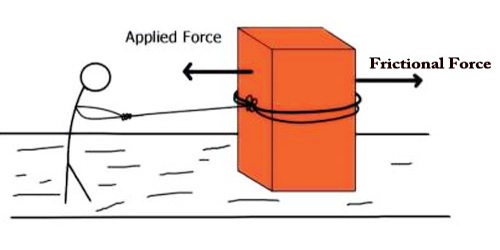When an object is moving, the friction is proportional and perpendicular to the normal force (N). Friction is independent of the area of contact as long as there is an area of contact. Friction is the force resisting the relative motion of solid surfaces, fluid layers, and material elements sliding against each other. There are several types of friction:
- Dry friction is a force that opposes the relative lateral motion of two solid surfaces in contact. Dry friction is subdivided into static friction (“stiction”) between non-moving surfaces, and kinetic friction between moving surfaces. With the exception of atomic or molecular friction, dry friction generally arises from the interaction of surface features, known as asperities
- Fluid friction describes the friction between layers of a viscous fluid that are moving relative to each other.
- Lubricated friction is a case of fluid friction where a lubricant fluid separates two solid surfaces.
- Skin friction is a component of drag, the force resisting the motion of a fluid across the surface of a body.
- Internal friction is the force resisting motion between the elements making up a solid material while it undergoes deformation.
Frictional force refers to the force generated by two surfaces that contacts and slide against each other. A few factors affecting the frictional force:
- These forces are mainly affected by the surface texture and amount of force impelling them together.
- The angle and position of the object affect the amount of frictional force.
- If an object is placed flat against an object, then the frictional force will be equal to the weight of the object.
- If an object is pushed against the surface, then the frictional force will be increased and becomes more than the weight of the object.
Friction is a component of the science of tribology. It is desirable and important in supplying traction to facilitate motion on land. Most land vehicles rely on friction for acceleration, deceleration, and changing direction. Sudden reductions in traction can cause loss of control and accidents.
Friction is not itself a fundamental force. Dry friction arises from a combination of inter-surface adhesion, surface roughness, surface deformation, and surface contamination. The complexity of these interactions makes the calculation of friction from first principles impractical and necessitates the use of empirical methods for analysis and the development of theory. Friction is a non-conservative force – work done against friction is path-dependent. In the presence of friction, some kinetic energy is always transformed to thermal energy, so mechanical energy is not conserved.
Calculating the Force of Friction –
The maximum amount of friction force that a surface can apply upon an object can be easily calculated with the use of the given formula:
Ffrict = µ • Fnorm
Here we have provided methodical steps to follow while calculating the force of friction.
Find the Normal Force – The normal force is the support force exerted upon an object that is in contact with another stable object. The normal force can be simply described in most cases by the following formula:
N = mg
In this formula, m describes the mass of the object, and g stands for the acceleration due to gravity. In case of an inclined surface, the strength of the normal surface is reduced the more the surface is inclined, hence the formula becomes:
N = mg cos(θ)
θ represents the angle the surface is inclined to.
In a simple calculation, you would calculate the normal force of a 2-kg block of wood sitting on a surface as:
N = 2 kg × 9.8 N/kg = 19.6 N
Finding the Right Co-efficient – The co-efficient that you would choose depends on the object and the specific situation. If the object isn’t moving across the surface, you use the coefficient of static frictionμstatic, but if the object under consideration is moving you use the coefficient of sliding friction μslide. The type of materials used also affects the co-efficient. For example, if a block wood was on a brick surface, the coefficient would be 0.6, but if it were on a block of clean wood, it would range from 0.25 to 0.5.
Calculating Frictional Force: As discussed, the formula for frictional force is given by F = μN. As an example, let us consider the block of wood that weighs 2-kg resting on a table to be pushed from rest. In this case, we consider the static friction co-efficient. 0.5 is the static co-efficient of wood. With the given details, we can calculate the normal force as
N = 2kg × 9.8 N/kg = 19.6 N
Now that we have the values of normal force and static friction co-efficient, we can calculate the frictional force as follows:
F = 0.5 × 19.6 N = 9.8 N
When a moving body is suddenly stopped, then frictional force arises when there is a relative motion between two surfaces. When the body is stopped means there is no relative motion and no resultant force is there hence frictional force acting becomes zero.
When two bodies are kept in contact, electromagnetic forces act between the charged particles at the surfaces of the bodies. Thus, each body exerts a contact force of the other. The magnitudes of the contact forces acting on the two bodies are equal but their directions are opposite and therefore the contact forces obye Newton’s third law.
The direction of the contact forces acting on a body is not necessarily perpendicular to the contact surface. The resolution of contact forces in two components i.e. perpendicular to contact surface and along the surface. Perpendicular component is normal force and parallel component is friction.
∴ R= f2+N2)
R – Contact force
According to the law of conservation of energy, no energy is destroyed due to friction, though it may be lost to the system of concern. Energy is transformed from other forms into thermal energy. A sliding hockey puck comes to rest because friction converts its kinetic energy into heat which raises the thermal energy of the puck and the ice surface. Since heat quickly dissipates, many early philosophers, including Aristotle, wrongly concluded that moving objects lose energy without a driving force.
Information Sources:
















